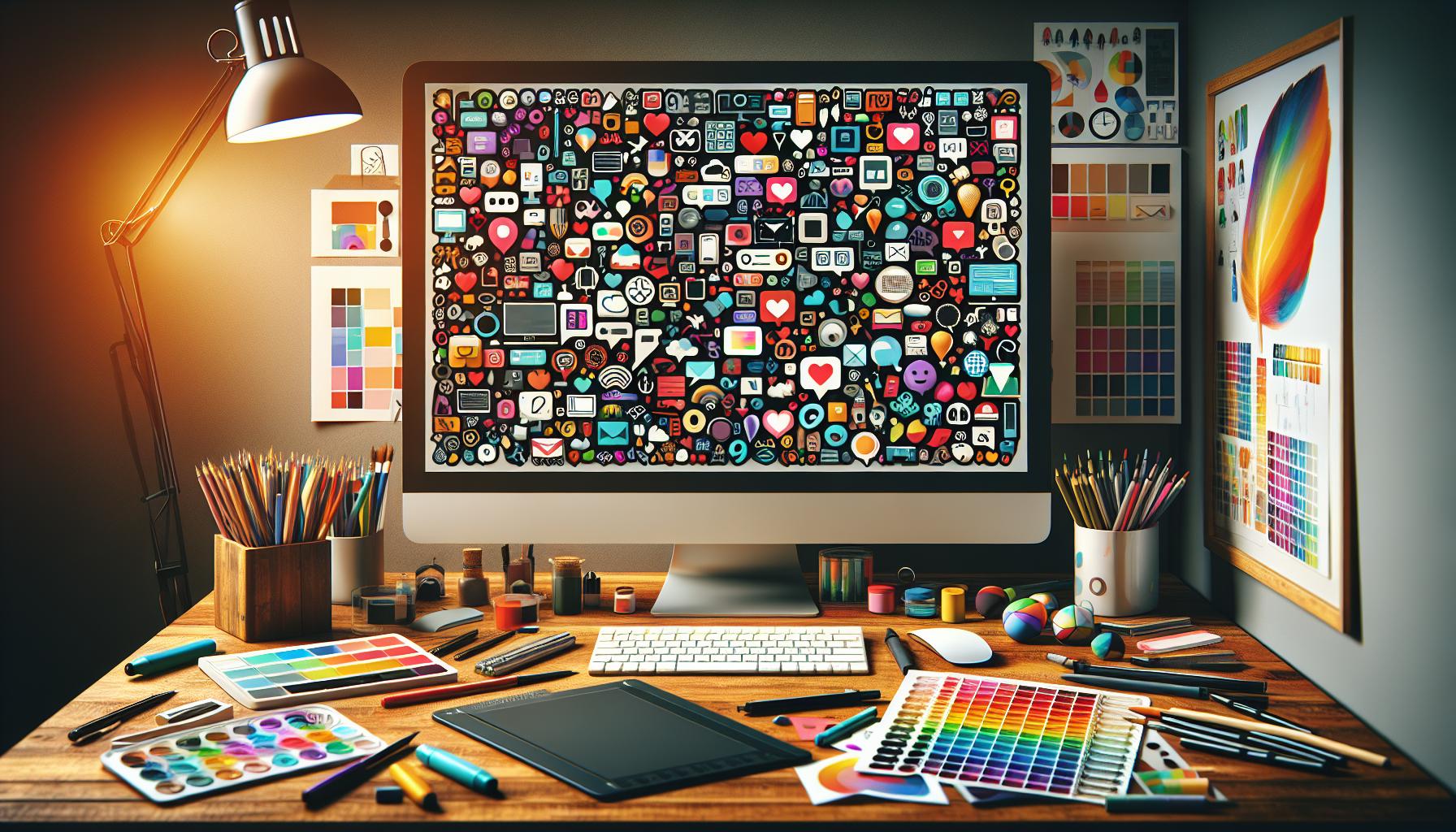The Best Fluffy Pancakes recipe you will fall in love with. Full of tips and tricks to help you make the best pancakes.
Digital media clipart has revolutionized the way designers and content creators enhance their visual projects. These ready-to-use digital illustrations offer endless possibilities for both personal and commercial applications while saving valuable time and resources.
In today’s digital landscape where visual content reigns supreme these versatile graphic elements have become essential tools for businesses social media managers and creative professionals. From simple icons to elaborate illustrations clipart collections provide instant access to professional-grade design elements that can elevate any project’s visual appeal. The growing demand for digital clipart has sparked an entire industry of artists and platforms dedicated to creating and distributing these valuable design assets.
What Is Digital Media Clipart
Digital media clipart consists of pre-made digital illustrations, graphics, or images designed for easy integration into various digital projects. These visual elements come in multiple file formats, offering flexibility for different design needs.
Types of Digital Clipart Formats
- Vector Graphics (SVG, AI, EPS)
- Scalable without quality loss
- Editable design elements
- Smaller file sizes
- Raster Images (PNG, JPEG)
- Fixed resolution graphics
- Transparency support (PNG)
- Web-optimized formats
- Mixed Format Collections
- Layered PSD files
- Combination vector-raster packages
- Multi-resolution assets
- Digital Marketing
- Social media posts
- Email newsletters
- Digital advertisements
- Educational Materials
- Presentation slides
- E-learning content
- Educational worksheets
- Business Documents
- Company reports
- Infographics
- Corporate presentations
- Web Design
- Website graphics
- Blog post illustrations
- Landing page elements
| Format Type | Resolution Dependency | File Size | Editability |
|---|---|---|---|
| Vector | No | Small | High |
| Raster | Yes | Large | Limited |
| Mixed | Varies | Medium | Medium |
Finding Quality Digital Media Clipart

Digital media clipart sources offer extensive collections of visual elements for creative projects. The key to successful design implementation lies in identifying reliable sources and understanding licensing options.
Popular Clipart Websites and Resources
Established platforms provide curated collections of digital clipart with diverse styles and categories:
- Vecteezy features 300,000+ vector graphics with advanced search filters
- Freepik maintains a library of 2.5 million design elements updated daily
- Creative Market hosts 65,000+ independent artists selling unique clipart
- Shutterstock offers 350 million+ premium images including vector clipart
- Adobe Stock integrates seamlessly with Creative Cloud applications
Top platforms enable search refinement by:
- File format (SVG, PNG, AI, EPS)
- Style categories (flat, outline, watercolor)
- Color schemes (monochrome, multicolor, custom palettes)
- Usage rights (commercial, editorial, extended license)
| Feature | Free Clipart | Premium Clipart |
|---|---|---|
| File Quality | 72-150 DPI | 300+ DPI |
| Format Options | PNG, JPG | AI, EPS, SVG, PNG |
| Monthly Updates | 100-500 items | 10,000+ items |
| License Type | Personal use | Commercial use |
| Support | Basic | Priority |
| Price | $0 | $15-99/month |
Free clipart repositories provide:
- Basic vector elements for personal projects
- Watermarked preview versions
- Limited commercial usage rights
- Standard resolution downloads
- High-resolution source files
- Editable vector formats
- Extended licensing options
- Regular content updates
- Advanced search capabilities
- Technical support services
Creating Your Own Digital Clipart
Digital clipart creation combines artistic skill with technical expertise to produce versatile graphic elements. This section explores the tools needed and best practices for creating professional-quality clipart.
Essential Design Tools and Software
Professional clipart creation relies on industry-standard design applications and supporting tools:
Vector Graphics Software:
- Adobe Illustrator: Industry standard for vector art creation with advanced pen tools
- Inkscape: Open-source alternative with comprehensive vector editing capabilities
- Affinity Designer: Cost-effective software with professional-grade features
Raster Graphics Programs:
- Adobe Photoshop: Premium photo editing with extensive brush libraries
- GIMP: Free image manipulation program with layer support
- Krita: Digital painting software with customizable brushes
Hardware Requirements:
- Graphics tablet: Wacom Intuos or XP-Pen devices for precise control
- High-resolution monitor: 4K display for accurate color representation
- Processing power: 16GB RAM minimum for smooth operation
Best Practices for Clipart Creation
Design principles and technical considerations for creating high-quality clipart:
File Format Standards:
- Save vectors in SVG format for web compatibility
- Export PNG files with transparent backgrounds
- Maintain AI or PSD source files for future editing
Design Elements:
- Create clean outlines with smooth anchor points
- Use consistent stroke weights throughout designs
- Implement a cohesive color palette with web-safe colors
- Resolution: 300 DPI for print-ready assets
- Canvas size: 2000×2000 pixels minimum for scalability
- Color mode: RGB for digital use CMYK for print
- Label layers descriptively
- Group related elements
- Maintain separate folders for different clipart categories
Copyright and Licensing Guidelines
Digital media clipart requires proper understanding of usage rights to avoid legal complications in both personal and commercial projects. Copyright laws protect creative works while licensing terms define how these assets can be used.
Understanding Usage Rights
Digital clipart licenses come in several distinct categories that determine usage permissions:
- Royalty-Free (RF): Enables unlimited use after one-time payment
- Rights-Managed (RM): Restricts usage based on specific parameters like duration time location
- Creative Commons (CC): Offers free use with varying attribution requirements
- Public Domain: Allows unrestricted use with no attribution needed
- Extended License: Permits merchandise creation resale products
| License Type | One-time Payment | Commercial Use | Modifications Allowed |
|---|---|---|---|
| Royalty-Free | Yes | Yes | Limited |
| Rights-Managed | Yes | Varies | No |
| Creative Commons | No | Varies | Yes |
| Public Domain | No | Yes | Yes |
| Extended License | Yes | Yes | Yes |
Proper Attribution Methods
Attribution requirements vary based on the clipart’s license type requiring specific elements:
- Creator Name: Include the original artist’s full name
- Source Link: Add URL to the original clipart location
- License Type: Specify the exact license agreement
- Modifications: Note any changes made to original artwork
- Platform Credits: Reference the marketplace or website source
Example attribution format:
Clipart by [Artist Name] from [Platform]
Licensed under [License Type]
Original source: [URL]
- Freepik: Requires “Designed by [Author] / Freepik”
- Vecteezy: Needs “Vector art by [Username] / Vecteezy”
- Shutterstock: Contains unique license ID references
- Adobe Stock: Includes asset-specific attribution codes
Incorporating Clipart in Digital Projects
Digital media clipart integration enhances visual projects through strategic placement and thoughtful implementation. Proper incorporation techniques maximize the impact of clipart elements while maintaining professional design standards.
Design Tips and Techniques
- Scale clipart proportionally to preserve image quality and maintain visual harmony
- Match clipart colors to the project’s existing color palette using hex codes
- Layer clipart elements with 20-30% transparency for subtle background effects
- Position clipart away from text edges with a minimum 15-pixel padding
- Group related clipart elements to create cohesive visual stories
- Apply consistent styling across multiple clipart pieces through unified effects
- Use grid alignment tools to ensure precise clipart placement
- Create focal points by varying clipart sizes (dominant pieces at 1.5x larger)
- Balance white space with a 60-40 ratio between content and clipart
- Organize clipart in categorized folders (icons, illustrations, backgrounds)
- Name files using descriptive conventions: project-type-date-version.extension
- Store master files in vector formats for maximum editing flexibility
- Create separate folders for different resolutions (72dpi web, 300dpi print)
- Maintain backup copies on cloud storage platforms
- Keep original source files separate from edited versions
- Document licensing information in a dedicated spreadsheet
- Tag files with relevant metadata for quick search access
- Compress final clipart files to reduce storage space (PNG-8 for web use)
- Archive unused clipart in dated folders for future reference
The content maintains flow from previous sections by building on the technical aspects while focusing on practical implementation strategies. Each subheading addresses specific aspects of clipart usage without repeating information from earlier sections about creation or sourcing.
Conclusion
Digital media clipart has revolutionized the way creators approach visual content in the digital age. From social media posts to educational materials its versatility makes it an indispensable tool for designers professionals and hobbyists alike.
The growing accessibility of both free and premium clipart resources along with user-friendly design tools has democratized digital creativity. Whether someone chooses to use existing clipart or create their own understanding licensing rights and maintaining organized collections ensures successful project implementation.
As digital media continues to evolve clipart remains a fundamental element in modern design providing endless possibilities for creative expression and professional communication.

